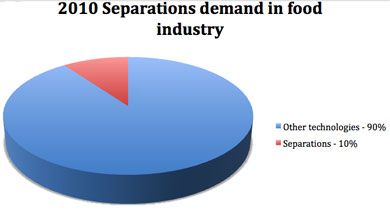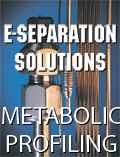Separations in the Food Industry
The global food, beverage, and agriculture industry caters to the population of the entire world. Even though the food industry does not rely on analytical instrumentation to the same extent as perhaps other industries, the sheer size of the industry results in a considerable market for such instruments.
The global food, beverage, and agriculture industry caters to the population of the entire world. Even though the food industry does not rely on analytical instrumentation to the same extent as perhaps other industries, the sheer size of the industry results in a considerable market for such instruments.

2010 Separations demand in food industry
Applications in food safety and security account for a large portion of the analytical instrumentation usage in the industry. Food research is another active area of study carried out in academia, government laboratories, and in laboratories within the commercial food industry. These studies focus on basic research in nutrition, the effect of diet on health, and the development of new genetically modified organisms, ingredients, and processes.
After product development is complete, quality control and process control are critical elements in the food industry. Again, analytical technologies are an important part of these tasks. Thus, although there can be some overlap, the main uses of analytical technologies are in promoting food security, food safety, food research, quality control, and process control.
The various separations technologies frequently used for food analysis are high performance liquid chromatography (HPLC), gas chromatography (GC), ion chromatography, low-pressure LC, flash chromatography, thin-layer chromatography, capillary electrophoresis, and chemical sensors. Separation techniques in the food industry are used for hundreds of applications, some of which include detection of aflatoxins in foods, amino acid analysis, vitamin separations, profiling various food components, analysis of colorants and residues, triglyceride determination, sugar content analysis, and determination of various other organic compounds
In 2010, the separations market accounted for about one-tenth of the total analytical instrumentation demand in the food industry. Demand for quality control applications and stronger mandates for food safety are expected to drive growth, particularly for LC–mass spectrometry (MS) and GC–MS systems.
The foregoing data were extracted and adapted from SDi’s Market Analysis and Perspective report entitled Food Testing and Analysis: Improving Quality and Assuring Safety. For more information, contact Glenn Cudiamat, VP of Research Services, Strategic Directions International, Inc., 6242 Westchester Parkway, Suite 100, Los Angeles, CA 90045, (310) 641-4982, fax: (310) 641-8851, e-mail: cudiamat@strategic-directions.com
Analytical Challenges in Measuring Migration from Food Contact Materials
November 2nd 2015Food contact materials contain low molecular weight additives and processing aids which can migrate into foods leading to trace levels of contamination. Food safety is ensured through regulations, comprising compositional controls and migration limits, which present a significant analytical challenge to the food industry to ensure compliance and demonstrate due diligence. Of the various analytical approaches, LC-MS/MS has proved to be an essential tool in monitoring migration of target compounds into foods, and more sophisticated approaches such as LC-high resolution MS (Orbitrap) are being increasingly used for untargeted analysis to monitor non-intentionally added substances. This podcast will provide an overview to this area, illustrated with various applications showing current approaches being employed.
Regulatory Deadlines and Supply Chain Challenges Take Center Stage in Nitrosamine Discussion
April 10th 2025During an LCGC International peer exchange, Aloka Srinivasan, Mayank Bhanti, and Amber Burch discussed the regulatory deadlines and supply chain challenges that come with nitrosamine analysis.

.png&w=3840&q=75)

.png&w=3840&q=75)



.png&w=3840&q=75)



.png&w=3840&q=75)



